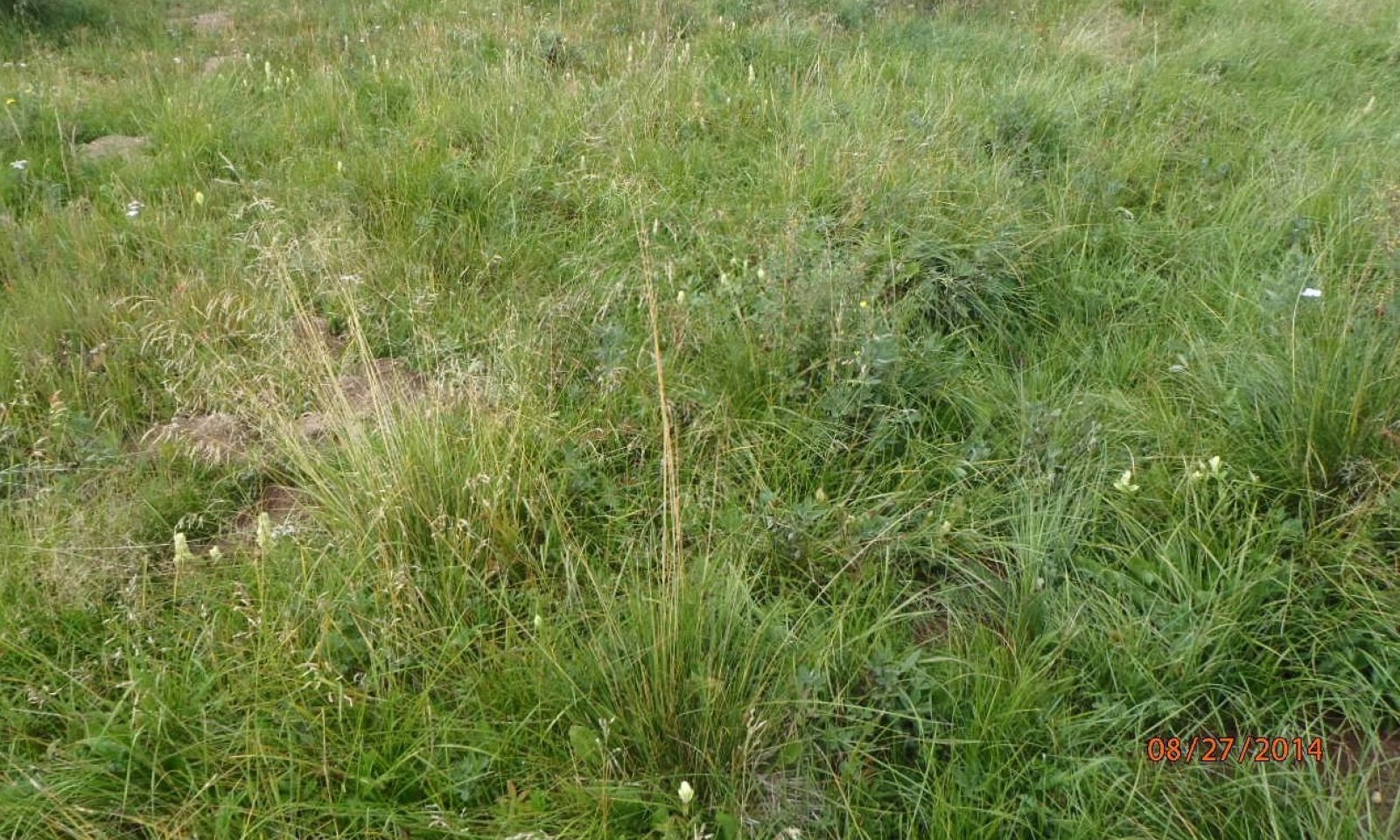

Natural Resources
Conservation Service
Ecological site R051XY315CO
Wet Meadow 6-10 PZ
Last updated: 12/12/2024
Accessed: 12/21/2025
General information
Provisional. A provisional ecological site description has undergone quality control and quality assurance review. It contains a working state and transition model and enough information to identify the ecological site.
MLRA notes
Major Land Resource Area (MLRA): 051X–High Intermountain Valleys
This MLRA encompasses the San Luis Valley in south central Colorado and the Taos Plateau and Taos alluvial piedmonts of north central New Mexico. As part of the northern portion of the Rio Grande Rift, the MLRA consists of large, alluvium filled basins washed down from adjacent mountain ranges. The Rio Grande River flows through this MLRA, continuing its long function of carrying mountain sediment down to the basin. Cenozoic volcanism is an extensive characteristic of the MLRA where large basalt flows with volcanic hills and domes are abundant. Ancient Lake Alamosa is a large feature within the MLRA.
Classification relationships
NRCS:
Major Land Resource Area 51, High Intermountain Valleys (United States Department of Agriculture, Natural Resources Conservation Service, 2006).
USFS:
331J – Northern Rio Grande Basin M331Ic > 331Ja - San Luis Valley, 331Jb - San Luis Hills and 331C - Mogotes
EPA:
22 - Arizona/New Mexico Plateau > 22a - San Luis Shrublands and Hills ; 22b -San Luis Alluvial Flats and Wetlands ; 22c - Salt Flats; 22e - Sand Dunes and Sand Sheets and 22f -Taos Plateau (Griffith, 2006).
USGS:
Southern Rocky Mountain Province
Ecological site concept
The wet meadow site occurs on nearly level to gently sloping flood plains. It commonly forms a narrow band next to a flowing stream. Grasses and grass-like plants make up most of the cover. Tufted hairgrass and Nebraska sedge are usually dominant on the wettest portions and slender and western wheatgrasses on the driest parts. Soils have developed on alluvial deposits under dense grass cover. The majority of wet meadows in the San Luis Valley have been supplemented with surface water and have been seeded with forage grasses such as meadow brome, meadow creeping foxtail, orchardgrass, and timothy.
Associated sites
| R051XY267CO |
Salt Meadow Salt Meadows occur as thin bands between the salt flats and the wet meadows. And sometimes the two are intermingled. Salt meadows support higher amounts of salt tolerant species such as alkali sacaton and inland saltgrass. |
|---|---|
| R051XY278CO |
Valley Bench 8-12 PZ Soils are formed in alluvium derived from granite, gneiss, and mica schist. The taxonomic particle size class can rage from fine-loamy to loamy skeletal. Surface textures range from loam to sandy loam. |
| R051XY294CO |
Valley Sand The Valley Sand exists on the basin floor where soils are course-textured. |
| R051XY281CO |
Mountain Outwash The Mountain Outwash site is made up of deep alluvium on the slope. |
Similar sites
| R051XY267CO |
Salt Meadow Salt Meadows occur as thin bands between the salt flats and the wet meadows. And sometimes the two are intermingled. Salt meadows support higher amounts of salt tolerant species such as alkali sacaton and inland saltgrass. |
|---|---|
| R051XY263CO |
Salt Flats Salt Flats occur in higher areas above the floodplain. Salt Flats are characterized by greasewood and tall warm-season grasses with intermittent slick spots. |

Figure 1.
Table 1. Dominant plant species
| Tree |
Not specified |
|---|---|
| Shrub |
Not specified |
| Herbaceous |
(1) Deschampsia cespitosa |
Physiographic features
This site is on nearly level to gently sloping floodplains, stream terraces. valley floors and swales. In places there are small irregularities caused by slightly higher or lower spots, Slopes are generally less than 1 percent and are insignificant to plant growth. Elevation is between 7500 and 8300 feet.
Table 2. Representative physiographic features
| Landforms |
(1)
Flood plain
(2) Alluvial fan (3) Stream terrace (4) Valley floor (5) Fan (6) Swale |
|---|---|
| Runoff class | Low to very high |
| Flooding duration | Very brief (4 to 48 hours) to brief (2 to 7 days) |
| Flooding frequency | Rare to frequent |
| Ponding frequency | None |
| Elevation | 7,500 – 8,300 ft |
| Slope | 3% |
| Water table depth | 12 – 42 in |
Climatic features
The climate that typifies the High Intermountain Valley, ranges from arid to semi-arid, and is characterized by cold winters, moderate summers, and much sunshine. Average annual precipitation ranges from 6 to 10 inches along the valley floor and throughout most of the resource area. Precipitation extremes vary from 3 to 20 inches per year depending on location. The San Juan mountain range to the west and the Sangre de Cristo Mountains to the east intercept much of the precipitation causing a two-way rain shadow effect. Approximately 60 to 65 percent of the annual precipitation falls between May 1 and October 1, mostly from short duration high intensity thundershowers in July and August. Snowfall averages 34 inches annually; snow cover is light or patchy throughout much of the winter. Wind speeds average 7 miles per hour annually. High wind velocities are common in the spring.
Cold air from the encompassing mountain ranges drain into the valley and settle. This phenomena results in long cold winters and moderate summer temperatures. July is the hottest month and January is the coldest. Summer temperatures range from highs in the upper 70’s and low 80’s and occasionally reach to the mid 90o F. Summer nights are cool, with lows averaging in the mid 40’s. Temperatures of -20oF to -40oF can be expected each year and are common during some winters. Higher elevations can receive a dusting of snow as early as September 1. There is a 50% probability that the first frost in the fall will occur near September 16, and the last frost in the spring on about June 9. The average length of the growing season is 119 days and varies from 94 to 143 days. Summer humidity is low. Evaporation rates average lower than those of dry regions because of the cool climate.
Most major plant species initiate growth between mid May and late July, but growth may extend into September. Some cool season plants begin growth earlier and complete growth by mid June.
Table 3. Representative climatic features
| Frost-free period (characteristic range) | 70-83 days |
|---|---|
| Freeze-free period (characteristic range) | 97-107 days |
| Precipitation total (characteristic range) | 6-10 in |
| Frost-free period (actual range) | 69-83 days |
| Freeze-free period (actual range) | 94-108 days |
| Precipitation total (actual range) | 6-10 in |
| Frost-free period (average) | 76 days |
| Freeze-free period (average) | 102 days |
| Precipitation total (average) | 8 in |
Figure 2. Monthly precipitation range
Figure 3. Monthly minimum temperature range
Figure 4. Monthly maximum temperature range
Figure 5. Monthly average minimum and maximum temperature
Figure 6. Annual precipitation pattern
Figure 7. Annual average temperature pattern
Climate stations used
-
(1) ALAMOSA SAN LUIS AP [USW00023061], Alamosa, CO
-
(2) CENTER 4 SSW [USC00051458], Center, CO
-
(3) MONTE VISTA 2W [USC00055706], Monte Vista, CO
-
(4) MANASSA [USC00055322], La Jara, CO
Influencing water features
With its location adjacent to flowing rivers and streams, these sites are dependent on sub-irrigation and overflow, offsetting the low precipitation. River discharge rates change annually, directly impacting surrounding substrates in terms of water table depth and hydraulic connectivity to the stream course. During high flows the substrates can be supersaturated such that water moves to the surface. Low river flows cause adjacent substrates to store less water, causing a lowered water table. The water table is commonly 12 to 42 inches in depth and occurs from April to September.
Soil features
Soils have developed on alluvial deposits from granite, gneiss and mica schist. Occasionally, the alluvium is from basalt. Surface textures are mainly loam or clay loam which is high in organic matter. Soils are deep to very deep in depth. This soil may or may not have a sandy or sandy-skeletal layer which starts at depth of 12 to 40 inches. if present.
Soils vary in texture, and water-holding capacity, but have common soil-plant relationships because of water table, overflow, and low salt content.
Table 4. Representative soil features
| Parent material |
(1)
Alluvium
(2) Alluvium – granite and gneiss (3) Alluvium – mica schist (4) Alluvium – basalt (5) Alluvium – igneous rock |
|---|---|
| Surface texture |
(1) Loam (2) Clay loam (3) Sandy loam |
| Family particle size |
(1) Fine-loamy (2) Fine-loamy over sandy or sandy-skeletal (3) Clayey-skeletal over sandy or sandy-skeletal (4) Fine |
| Drainage class | Somewhat poorly drained to poorly drained |
| Permeability class | Moderately slow to moderate |
| Soil depth | 60 – 100 in |
| Surface fragment cover <=3" | 10% |
| Surface fragment cover >3" | 2% |
| Available water capacity (Depth not specified) |
4 – 7.5 in |
| Calcium carbonate equivalent (Depth not specified) |
10% |
| Electrical conductivity (Depth not specified) |
2 mmhos/cm |
| Sodium adsorption ratio (Depth not specified) |
2 |
| Soil reaction (1:1 water) (Depth not specified) |
6.6 – 8.5 |
| Subsurface fragment volume <=3" (Depth not specified) |
35% |
| Subsurface fragment volume >3" (Depth not specified) |
10% |
Ecological dynamics
Grasses and grass-like plants make up most of the cover. Tufted hairgrass and Nebraska sedge are usually dominant on the wettest portions and slender and western wheatgrasses on the driest parts. Others which may be present are bluejoint reedgrass, northern reedgrass, wedgegrass, mannagrass, American sloughgrass, and baltic rush. Alkali sacaton and mat muhly may show up along edges where the site intergrades with the salt meadow site. In places, alkali sacaton is prominent on small high spots which are inclusions of salt meadow and along higher streambanks that are not inundated with overflow.
Forbs are a minor component of the plant production but there is high species richness. Among the most common are New Mexico checkermallow, American vetch, native clovers, Rocky Mountain iris, wild licorice, herbaceous cinquefoils, western yarrow, golden banner, gentian, and water hemlock. Small clumps of wild rose and willows will grow along the streambank. Tree species do not normally grow on the site. However, an occasional cottonwood may come into areas bordering the river corridor.
The majority of wet meadows in the San Luis Valley have been supplemented with surface irrigation and have been seeded with forage grasses such as meadow brome, meadow creeping foxtail, orchardgrass, and timothy.
State and transition model
More interactive model formats are also available.
View Interactive Models
Click on state and transition labels to scroll to the respective text
Ecosystem states
State 1 submodel, plant communities
State 2 submodel, plant communities
State 3 submodel, plant communities
State 1
Reference

Figure 8. Reference Community Phase
This state is dominated by tufted hairgrass and nebraska sedge in the wettest portions of the ecological site and grades toward slender wheat and western wheat where the site becomes drier. Small clumps of wild rose and willow will grow along stream banks and marshy areas.
Dominant plant species
-
tufted hairgrass (Deschampsia cespitosa), grass
-
Nebraska sedge (Carex nebrascensis), grass
-
slender wheatgrass (Elymus trachycaulus), grass
Community 1.1
Tufted Hairgrass and Nebraska Sedge

Figure 9. Reference Community Phase
The reference community phase is dominated by a mix of cool season grass and grasslikes. Tufted hairgrass and Nebraska sedge usually dominate on the wetter portions of the ecological site.Slender wheatgrass and western wheatgrass may dominate on the driest parts. Alkali sacaton and mat muhly may show up along edges where the site grades into the salt meadow.
Resilience management. This community phase is the most resilient to disturbance as a diversity of plants and root systems anchor the site during times of flood and reach deep for moisture during periodic periods of drought.
Dominant plant species
-
tufted hairgrass (Deschampsia cespitosa), grass
-
Nebraska sedge (Carex nebrascensis), grass
Figure 10. Annual production by plant type (representative values) or group (midpoint values)
Table 5. Annual production by plant type
| Plant type | Low (lb/acre) |
Representative value (lb/acre) |
High (lb/acre) |
|---|---|---|---|
| Grass/Grasslike | 1895 | 2365 | 2835 |
| Forb | 100 | 125 | 150 |
| Shrub/Vine | 5 | 10 | 15 |
| Total | 2000 | 2500 | 3000 |
Figure 11. Plant community growth curve (percent production by month). CO5108, Cool-season Dominant Warm-season Subdominant, MLRA 51 Alluvial Fans & fan Remnants. Reference Plant Community for Chico Fan located in LRU 51-5 on fans and fan remnants above valley floor, pre-dominantly in areas surrounding Villa Grove and Saguache, Saguache County..
| Jan | Feb | Mar | Apr | May | Jun | Jul | Aug | Sep | Oct | Nov | Dec |
|---|---|---|---|---|---|---|---|---|---|---|---|
| J | F | M | A | M | J | J | A | S | O | N | D |
| 0 | 0 | 0 | 3 | 30 | 25 | 20 | 12 | 10 | 0 | 0 | 0 |
Community 1.2
Streambank
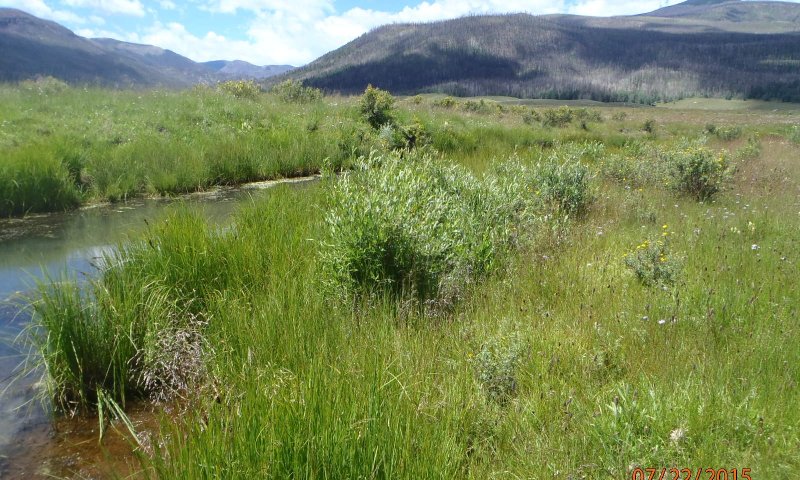
Figure 12. Tufted hairgrass, sedges, and willows are more abundant along the stream bank
The wet meadow site resides in the floodplain of the stream. The stream itself is dynamic and meanders. Vegetation along the stream-bank may include wild rose, willow, cattails, bulrush, and horsetail. Tufted hairgrass and Nebraska sedge will also be present.
Pathway 1.1A
Community 1.1 to 1.2


The stream meanders and changes overtime and what was once floodplain may in the future become stream-bank.
Pathway 1.2A
Community 1.2 to 1.1


As the stream meanders what was once channel and stream-bank will become floodplain.
State 2
Degraded
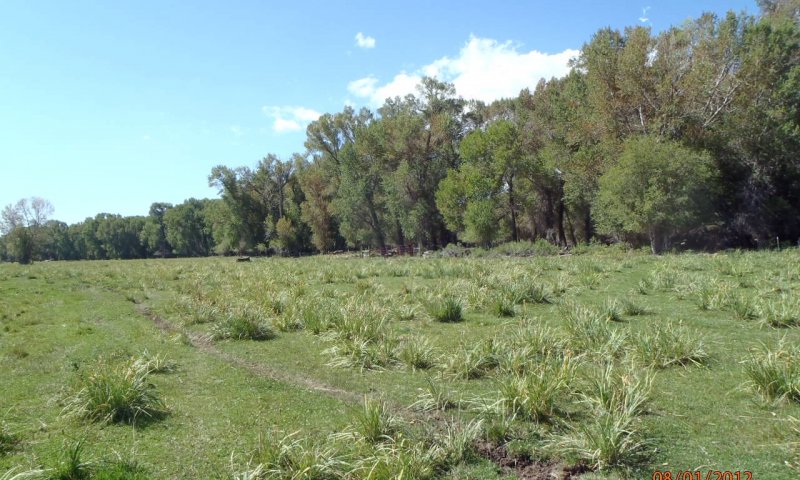
Many of the desirable cool season grasses/grasslikes have decreased such as tufted hairgrass, Nebraska sedge, slender wheatgrass, and western wheatgrass. Undesirable grass and forb species have increased including: baltic rush, low sedges, mat muhly, Rocky Mountain Iris, cinquefoils, and water hemlock. The soil surface may become broken and hummocky.
Resilience management. Resilience to disturbance is lowest in the degraded state. Soils often become compacted decreasing the sites' ability to absorb water during flood events. This in turn increases runoff and stream channel degradation.
Community 2.1
Degraded, Low Function
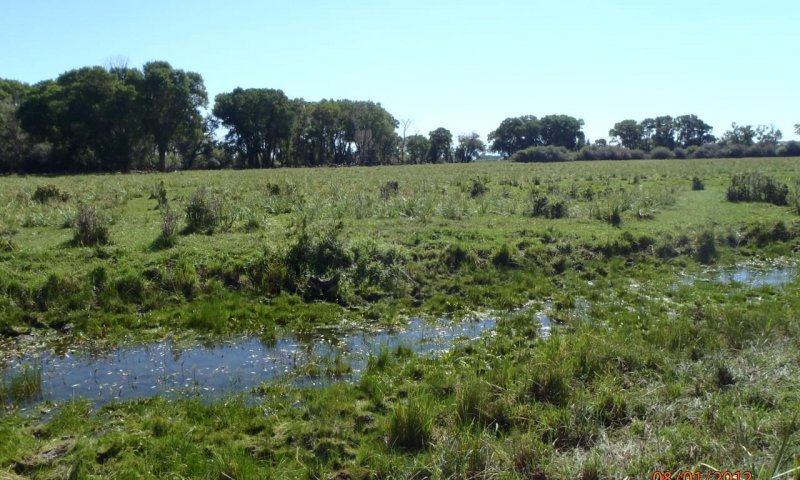
Figure 13. Site shows low plant production, hummocks and shearing.
There has been an increase in plants that provide minimal riparian services. Plants that are common in this community include: baltic rush, low sedges, mat muhly, Rocky Mountain iris, shrubby cinquefoil, herbaceous cinquefoils, Kentucky bluegrass, and water hemlock.
Resilience management. A primary function for a wet meadow is to absorb and slowly release flood water. In the degraded state, low absorption community, run-off is highest. Soils may be compacted, hummocked, and sheared. Soil organic matter is lowest in this community and runoff and damage to associated stream corridors is greatest.
Community 2.2
Degraded, Foxtail Barley and Bare Ground
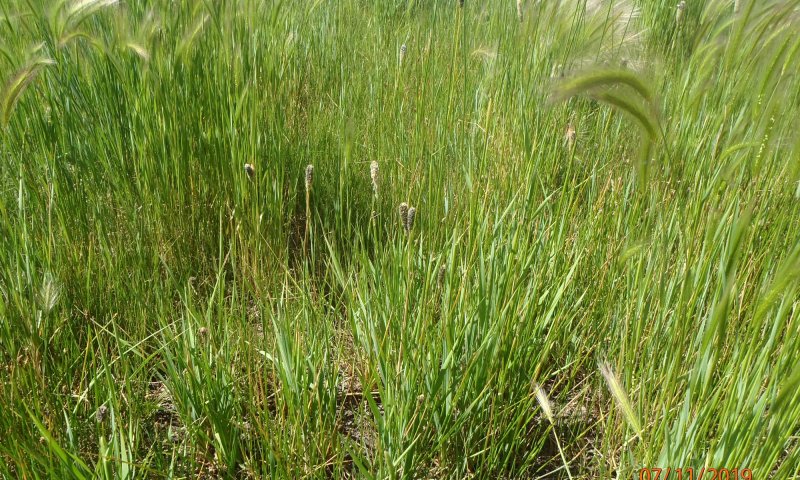
Figure 14. Dominant foxtail barley
Foxtail barley is the main species that has colonized the site. Bare ground is high and plant density is low. Foxtail barley is a shallow-rooted species that takes advantage of degraded sites and early spring runoff.
Resilience management. This degraded community has decreased resilience to disturbance. Resilience to both flooding and drought is minimal and can lead to stream channel erosion. Foxtail barley, is also a early spring species, drying up in the heat of the summer.
Community 2.3
Low Diversity, Increased Production

Figure 15. Low Diversity-Increased Production
This community has improved ecological processes and is on the way toward site restoration. Production, root systems, organic matter and water absorption have all increased. Plant diversity and soil health have yet to be restored to reference conditions.
Resilience management. This community is on the way toward restoration.
Pathway 2.1A
Community 2.1 to 2.2


Foxtail barley responds to areas that get late fall water, which is pooled, freezes, and then adds to early spring run-off.
Pathway 2.1B
Community 2.1 to 2.3


Grazing management to begin restoration. Often spring deferment to allow cool season species to tiller, seed, and colonize.
Pathway 2.2A
Community 2.2 to 2.1


The lack of fall moisture and early spring runoff, not allowing this early spring species to tiller and produce an inflorescence.
Pathway 2.3A
Community 2.3 to 2.1


A set back in management, repetitively grazing cool season species during the critical growing season with high intensities and frequencies.
Land use 3
Pastureland
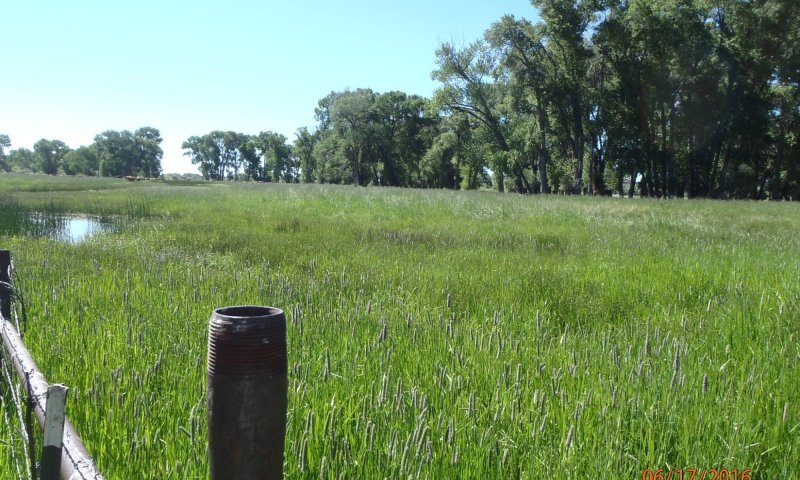
The wet meadow ecological site is often seeded to introduced hay and pasture grasses. Common grasses include: meadow brome, meadow creeping foxtail, orchardgrass, and timothy. The seeded pasture can then be grazed or hayed.
Community 3.1
Introduced Hay Meadow
Species include: meadow brome, meadow creeping foxtail, orchardgrass, and timothy. Regular irrigation and cuttings are a part of the management.
Community 3.2
Sod Bound Hay Meadow
Over time rhizomotous species gain a competitive advantage and overall production declines.
Community 3.3
Pasture Grazing
Pasture grazing in a managed situation. High intensity-short duration grazing is recommended during the growing season. During the dormant season, utilization of less than 50 percent is recommended.
Pathway 3.1A
Community 3.1 to 3.2
Over time, rhizomatous species such as smooth brome and creeping meadow foxtail decrease plant diversity and may decrease productivity of the hay meadow.
Pathway 3.1B
Community 3.1 to 3.3
Cattle grazing using best management practices along with irrigation.
Pathway 3.2A
Community 3.2 to 3.1
Mechanical treatment such as ripping and possible seeding needed.
Pathway 3.3A
Community 3.3 to 3.1
Transitioning from irrigated pasture to irrigated hay meadow.
Transition T1B
State 1 to 3


Converting rangeland to introduced hayland or pastureland.
Restoration pathway R3A
State 3 to 1


Converting pasture to rangeland takes time and inputs.
Additional community tables
Table 6. Community 1.1 plant community composition
| Group | Common name | Symbol | Scientific name | Annual production (lb/acre) | Foliar cover (%) | |
|---|---|---|---|---|---|---|
|
Grass/Grasslike
|
||||||
| 1 | Grasses/Grasslikes | 1900–2900 | ||||
| tufted hairgrass | DECE | Deschampsia cespitosa | 600–900 | – | ||
| Nebraska sedge | CANE2 | Carex nebrascensis | 400–600 | – | ||
| slender wheatgrass | ELTR7 | Elymus trachycaulus | 400–600 | – | ||
| western wheatgrass | PASM | Pascopyrum smithii | 300–400 | – | ||
| bluejoint | CACA4 | Calamagrostis canadensis | 200–300 | – | ||
| northern reedgrass | CASTI3 | Calamagrostis stricta ssp. inexpansa | 200–300 | – | ||
| mat muhly | MURI | Muhlenbergia richardsonis | 100–150 | – | ||
| mountain rush | JUARL | Juncus arcticus ssp. littoralis | 100–150 | – | ||
| smallwing sedge | CAMI7 | Carex microptera | 100–150 | – | ||
| American mannagrass | GLGR | Glyceria grandis | 50–100 | – | ||
| fowl mannagrass | GLST | Glyceria striata | 50–100 | – | ||
| foxtail barley | HOJU | Hordeum jubatum | 0–50 | – | ||
| Grass-like (not a true grass) | 2GL | Grass-like (not a true grass) | 0–50 | – | ||
| Grass, perennial | 2GP | Grass, perennial | 0–50 | – | ||
| Nuttall's alkaligrass | PUNU2 | Puccinellia nuttalliana | 0–20 | – | ||
| alkali sacaton | SPAI | Sporobolus airoides | 0–20 | – | ||
|
Forb
|
||||||
| 2 | Forbs | 100–250 | ||||
| common yarrow | ACMI2 | Achillea millefolium | 0–5 | – | ||
| purple milkvetch | ASAG2 | Astragalus agrestis | 0–5 | – | ||
| spotted water hemlock | CIMA2 | Cicuta maculata | 0–5 | – | ||
| willowherb | EPILO | Epilobium | 0–5 | – | ||
| scouringrush horsetail | EQHY | Equisetum hyemale | 0–5 | – | ||
| cinquefoil | POTEN | Potentilla | 0–5 | – | ||
| Forb (herbaceous, not grass nor grass-like) | 2FORB | Forb (herbaceous, not grass nor grass-like) | 0–5 | – | ||
| American licorice | GLLE3 | Glycyrrhiza lepidota | 0–5 | – | ||
| Rocky Mountain iris | IRMI | Iris missouriensis | 0–5 | – | ||
| salt spring checkerbloom | SINE3 | Sidalcea neomexicana | 2–5 | – | ||
| clover | TRIFO | Trifolium | 0–5 | – | ||
| Mexican dock | RUSAM | Rumex salicifolius var. mexicanus | 0–3 | – | ||
| Nuttall's sunflower | HENU | Helianthus nuttallii | 0–3 | – | ||
| gentian | GENTI | Gentiana | 0–3 | – | ||
| American vetch | VIAM | Vicia americana | 0–2 | – | ||
| mountain goldenbanner | THMO6 | Thermopsis montana | 0–2 | – | ||
|
Shrub/Vine
|
||||||
| 3 | Shrubs | 0–25 | ||||
| shrubby cinquefoil | DAFR6 | Dasiphora fruticosa | 0–5 | – | ||
| Woods' rose | ROWO | Rosa woodsii | 0–5 | – | ||
| willow | SALIX | Salix | 0–5 | – | ||
| whitestem gooseberry | RIIN2 | Ribes inerme | 0–3 | – | ||
Interpretations
Supporting information
Inventory data references
Along Ventura Creek, south of Sanchez Reservoit and about 2 miles north of the New Mexico line in Costilla County.
Field Offices in Colorado where the site occurs:
Alamosa, Center, and San Luis
References
-
. 2021 (Date accessed). USDA PLANTS Database. http://plants.usda.gov.
Other references
Chapman, S.S., G.E. Griffith, J.M. Omernik, A.B. Price, J. Freeouf, and D.L. Schrupp. 2006. Ecoregions of Colorado. (2-sided color posterwith map, descriptive text, summary tables, and photographs). U.S. Geological Survey, Reston, VA. Scale 1:1,200,000.
Cleland, D.T.; Freeouf, J.A.; Keys, J.E.; Nowacki, G.J.; Carpenter, C.A.; and McNab, W.H. 2007. Ecological Subregions: Sections andSubsections for the conterminous United States. Gen. Tech. Report WO-76D [Map on CD-ROM] (A.M. Sloan, cartographer). Washington,DC: U.S. Department of Agriculture, Forest Service, presentation scale 1:3,500,000; colored.
Soil Conservation Service (SCS). August 1975. Range Site Description for Wet Meadow #315. : USDA, Denver Colorado.
United States Department of Agriculture, Natural Resources Conservation Service. 2006. Land Resource Regions and Major Land Resource Areas of the United States, the Caribbean, and the Pacific Basin. U.S. Department of Agriculture Handbook 296.
Contributors
C. Villa, S. Woodall, H. Garcia
Suzanne Mayne-Kinney
Approval
Kirt Walstad, 12/12/2024
Acknowledgments
Project Staff:
Suzanne Mayne-Kinney, Ecological Site Specialist, NRCS MLRA, Grand Junction SSO
Alan Stuebe, MLRA Soil Survey Leader, NRCS MLRA Alamosa SSO
Program Support:
Rachel Murph, NRCS CO State Rangeland Management Specialist, Denver
Eva Muller, Regional Director, Rocky Mountain Regional Soil Survey Office, Bozeman, MT
B.J. Shoup, CO State Soil Scientist, Denver
Eugene Backhaus, CO State Resource Conservationist, Denver
--Site Development and Testing Plan--:
Future work to validate and further refine the information in this Provisional Ecological Site Description is necessary. This will include field activities to collect low-, medium-, and high-intensity sampling, soil correlations, and analysis of that data.
Additional information and data are required to refine the Plant Production and Annual Production tables for this ecological site. The extent of MLRA 51 must be further investigated.
Field testing of the information contained in this Provisional ESD is required. As this ESD is moved to the Approved ESD level, reviews from the technical team, quality control, quality assurance, and peers will be conducted.
Rangeland health reference sheet
Interpreting Indicators of Rangeland Health is a qualitative assessment protocol used to determine ecosystem condition based on benchmark characteristics described in the Reference Sheet. A suite of 17 (or more) indicators are typically considered in an assessment. The ecological site(s) representative of an assessment location must be known prior to applying the protocol and must be verified based on soils and climate. Current plant community cannot be used to identify the ecological site.
| Author(s)/participant(s) | K. Diller, H. Garcia, S. Woodall, C. Villa |
|---|---|
| Contact for lead author | Rachel Meade, CO State Rangeland Management Specialist |
| Date | 12/14/2004 |
| Approved by | Kirt Walstad |
| Approval date | |
| Composition (Indicators 10 and 12) based on | Annual Production |
Indicators
-
Number and extent of rills:
None -
Presence of water flow patterns:
None -
Number and height of erosional pedestals or terracettes:
None -
Bare ground from Ecological Site Description or other studies (rock, litter, lichen, moss, plant canopy are not bare ground):
None -
Number of gullies and erosion associated with gullies:
None -
Extent of wind scoured, blowouts and/or depositional areas:
None -
Amount of litter movement (describe size and distance expected to travel):
Litter movement is minimal and short. -
Soil surface (top few mm) resistance to erosion (stability values are averages - most sites will show a range of values):
Stability class rating anticipated to be 5-6 in interspaces at soil surface. -
Soil surface structure and SOM content (include type of structure and A-horizon color and thickness):
Surface soils textures range from loam, clay loam and sandy loam in texture. The A-horizon is light gray to brownish gray that can extend to 8 inches deep. The structure is typically weak or moderate fine granular structure -
Effect of community phase composition (relative proportion of different functional groups) and spatial distribution on infiltration and runoff:
Diverse grass, forb, shrub functional/structural groups and diverse root structure/patterns reduces raindrop impact slows overland flow providing increased time for infiltration to occur. -
Presence and thickness of compaction layer (usually none; describe soil profile features which may be mistaken for compaction on this site):
None -
Functional/Structural Groups (list in order of descending dominance by above-ground annual-production or live foliar cover using symbols: >>, >, = to indicate much greater than, greater than, and equal to):
Dominant:
warm season bunchgrass >Sub-dominant:
warm season rhizomatous > cool season rhizomatous >Other:
forbs > shrubsAdditional:
-
Amount of plant mortality and decadence (include which functional groups are expected to show mortality or decadence):
Minimum. Expect some natural mortality and decadence on grasses/sedges where excluded from grazing animals or wildfire. -
Average percent litter cover (%) and depth ( in):
60-75% litter cover at 1.0-3.0 inch depth. -
Expected annual annual-production (this is TOTAL above-ground annual-production, not just forage annual-production):
2000 lbs./ac. low precip years; 2500 lbs./ac. average precip years; 3000 lbs./ac. above average precip years. After extended drought, production will be significantly reduced to 400 – 800 lbs./ac. or more. -
Potential invasive (including noxious) species (native and non-native). List species which BOTH characterize degraded states and have the potential to become a dominant or co-dominant species on the ecological site if their future establishment and growth is not actively controlled by management interventions. Species that become dominant for only one to several years (e.g., short-term response to drought or wildfire) are not invasive plants. Note that unlike other indicators, we are describing what is NOT expected in the reference state for the ecological site:
None -
Perennial plant reproductive capability:
The only limitations are weather-related, natural disease, inter-species competition, wildlife, and insects that may temporarily reduce reproductive capability.
Print Options
Sections
Font
Other
The Ecosystem Dynamics Interpretive Tool is an information system framework developed by the USDA-ARS Jornada Experimental Range, USDA Natural Resources Conservation Service, and New Mexico State University.
Click on box and path labels to scroll to the respective text.